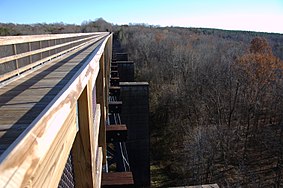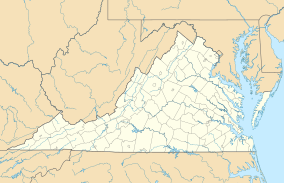High Bridge Trail State Park
| High Bridge Trail State Park | |
|---|---|

High Bridge at High Bridge Trail State Park
|
|
|
Location of High Bridge Trail State Park
|
|
| Location | Central and Southside Virginia, United States |
| Nearest city | Farmville, Virginia |
| Coordinates | 37°18′40.61″N 78°19′5.99″W / 37.3112806°N 78.3183306°WCoordinates: 37°18′40.61″N 78°19′5.99″W / 37.3112806°N 78.3183306°W |
| Area | 1,103 acres (446 ha) |
| Established | 2006 Completed: 2012 |
| Governing body | Virginia Department of Conservation and Recreation |
High Bridge Trail State Park is a rail trail in Southside Virginia converted from a rail line last belonging to Norfolk Southern.
The first section of the High Bridge Trail opened in 2008 and the final section was completed in 2012. With a length of more than thirty miles, the trail is shared by bicyclists, pedestrians and equestrians — and includes a restored crossing at the Appomattox River over the historic High Bridge – from which the park derives its name.
The lineal park traverses Appomattox, Nottoway, Cumberland, and Prince Edward counties as well as Pamplin City, Prospect, Farmville, Rice and Burkeville. Where the trail traverses Farmville, it directly adjoins Longwood University at the campus' satellite housing and athletic site.
High Bridge had been built in 1854 across the Appomattox River connecting Petersburg to Lynchburg. The bridge is 2,400 feet (730 m) long and ranges from 60 to 125 feet (18 to 38 m) high. It was originally made of wood, standing on 20 brick piers and included a pedestrian walkway next to the tracks and a nearby wagon bridge. During the American Civil War, both Union and Confederate forces attempted to destroy the bridge to their advantage. Confederates succeeded in setting the bridge on fire on April 6, 1865, to prevent its crossing by the Union. When Union troops arrived, 3 of the bridge's 21 wooden spans had burned and a 4th span was on fire. Union engineers successfully cut the 4th span to prevent further destruction of the bridge. After the Battle of High Bridge and his surrender at Appomattox, Robert E. Lee told the very men who had destroyed the bridge – including civil engineer Major General William Mahone – to go home and start its rebuilding. Engineers began building temporary spans to replace those that had been destroyed; the South Side Rail Road company eventually finished the work and rail traffic resumed in September 1865.
...
Wikipedia

